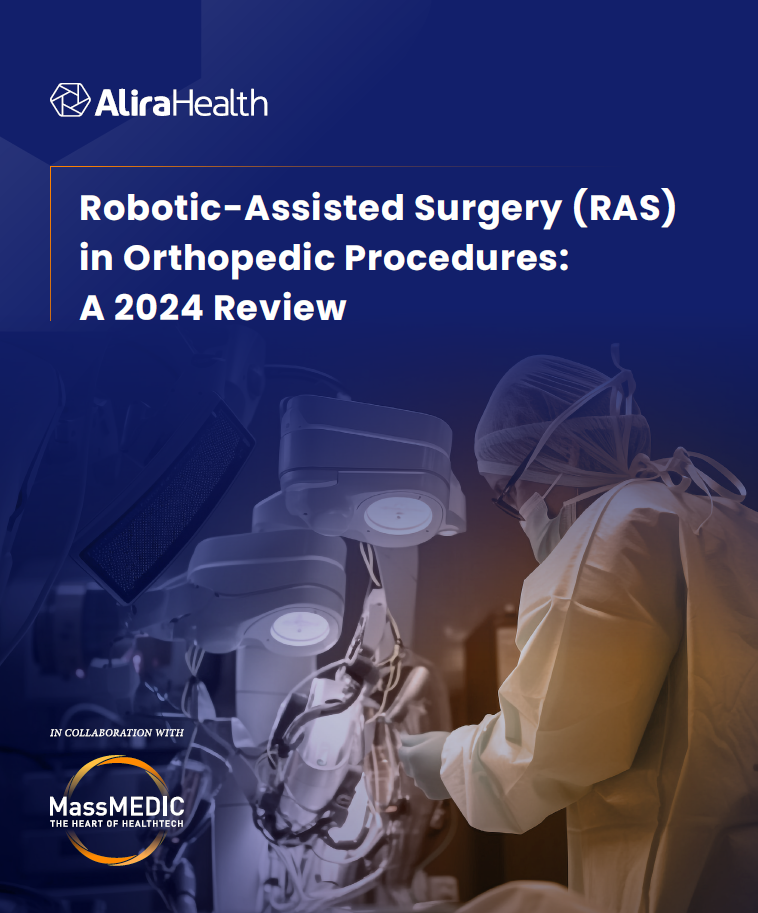Surgical Robotics Reshape Orthopedics: Opportunities and Challenges for the Medtech Industry in 2024
The medtech industry is undergoing a period of rapid transformation, driven by technological advancements, evolving patient needs, and changing healthcare dynamics. Within such a dynamic landscape, orthopedic surgeries stand out as a segment poised to reap significant benefits at the intersection of robotic-assisted surgery (RAS), digitalization, and data-driven healthcare.
In this article, we describe three key trends that are changing orthopedic surgery, discuss the challenges and opportunities for large medtech companies, and present guidance for manufacturers and investors looking to take advantage of this burgeoning market.
Three Key Trends Changing Orthopedic Surgery
Orthopedic surgery is undergoing a significant transformation, driven by three key trends.
Trend #1: ASCs
We observe a growing preference for Ambulatory Surgical Centers (ASCs) as the setting for procedures. This trend is fueled by a combination of factors:
- COVID-19 pandemic, which accelerated the shift to ASCs for Orthopedic procedures as hospitals sought to reduce patient volumes and minimize the risk of infection
- Medicare’s expansion of coverage for procedures performed at ASCs, including two common Orthopedic procedures – total knee replacements and total hip replacements – making them financially feasible
- ASC advantages including cost-effectiveness, patient convenience, and shorter recovery times
Trend #2: Aging Population
The aging population represents a growing customer base for Orthopedic procedures, driving demand for innovative and effective solutions that address their unique needs such as the increasing prevalence of chronic conditions (arthritis, osteoporosis, and joint pain), as well as the higher risk of falls and injuries.
Trend #3: Digitalization
Digitalization is transforming orthopedic procedures with the increasing adoption of RAS, imaging and visualization platforms, and workflow optimization technologies. These digital technologies are enabling a more personalized and data-driven approach to orthopedic care, leading to improved patient outcomes and reduced healthcare costs. However, their adoption also creates challenges including the need for specialized training for healthcare providers.
A Strategic Decision for Large Medtech Companies
In this landscape, where orthopedic RAS is increasingly common and presents an enormous opportunity, large medtech companies face a critical strategic decision. Should they:
- Focus on distributing and supporting robotic platforms developed by others
- Become a “portal” of robotics by aggregating and integrating various robotic solutions into a comprehensive platform
- Venture alone into robotics development, leveraging their financial resources, distribution networks, and clinical expertise to create their own proprietary robotic platforms
Each option has its own set of advantages and disadvantages. The distributor model offers the advantage of reduced risk and faster time to market, but it may limit the company’s ability to shape the future of the technology. The portal model provides greater flexibility and control over the product portfolio, but it may require a more significant investment of time and resources. And the development model offers the potential for the highest rewards, but it also carries the highest risk of failure.
Liabilities and Assets of Large Medtech Companies in Surgical Robotics
In addition to deciding how they will approach the orthopedic RAS opportunity, large medtech companies may face challenges in adapting to the rapid pace of innovation in surgical robotics. They often have complex organizational structures that can impede agile decision-making and make it difficult to adapt to the accelerated cycles of development and commercialization. Additionally, these companies may have a risk-averse culture that is, not conducive to disruptive innovations. Furthermore, internal bureaucracy and a lack of digitally native expertise can hinder their ability to fully embrace and integrate robotic technologies.
Despite these challenges, large medtech companies possess significant assets that can be leveraged in the RAS space. Their financial strength provides access to capital for investments in research and development. They often have access to a wide range of clinical expertise, which can help them develop and test new robotic platforms. These companies also have well-established distribution channels and field support infrastructure, enabling efficient market penetration of robotic solutions. Finally, their access to Key Opinion Leaders (KOLs) can facilitate the adoption and acceptance of new technologies within the medical community.
Seizing Opportunities in Orthopedic RAS: Key Considerations for Investors and Strategic Guidance for Medtech Companies
As the use of orthopedic RAS continues to grow, medtech companies should focus on developing innovative solutions that meet the needs of patients and providers in the ASC setting. They should also invest in digital technologies that can personalize care and improve patient outcomes. Additionally, companies should consider partnering with or acquiring startups to gain access to cutting-edge technologies and expertise.
Investors should look for medtech companies that are well-positioned to capitalize on these trends in orthopedics, displaying a strong track record of innovation, a deep understanding of the orthopedic market, and a commitment to investing in research and development. The future hinges on overcoming limitations and embracing innovation. By collaborating with startups and adapting to change, large strategics can shape the future of orthopedics and improve patient outcomes.

More RAS in Orthopedics Insights Now Available
Check out our latest report, Robotic-Assisted Surgery (RAS) in Orthopedic Procedures: A 2024 Review. Be among the first to read the report, which provides a comprehensive overview of the orthopedic RAS market landscape in the United States and Western Europe as well in-depth analysis, market trends, and insights into this transformative field.
Subscribe to our newsletter for the latest news, events, and thought leadership
